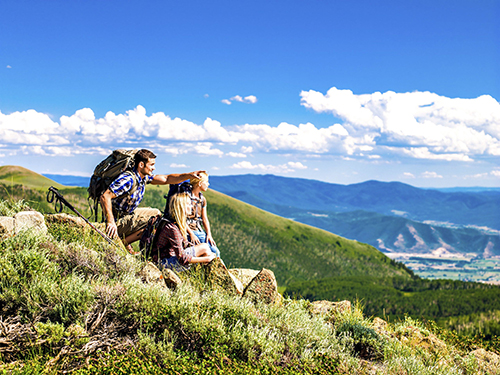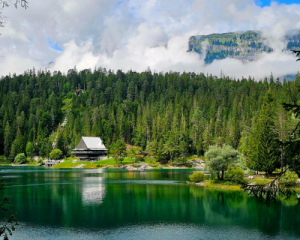
The wonders of hiking can be enjoyed by the whole family with just a bit of planning.
This is shaping up to be a spectacular hiking season. The early, drenching rains set the creeks flowing with water again. The warm sunshine interspersed among the storms provided just the right conditions for colorful wildflowers to pop open by mid-January.
If you haven’t taken your family out on the trail yet this year, don’t worry. The very best of the season is in March and April, when the blooms are at their most abundant, the hills are thick with greenery and the weather is generally mild, not too hot or cold for extended times outdoors.
Hiking is more than just a little time spent in nature. It’s transformative. It’s a form of meditation and mental health care as well as physical activity. Studies have found that hiking lifts mood and raises self-esteem. It relaxes us, and at the same time, the exposure to sunlight has been found to improve cognitive function. It’s one of the least expensive family outings you can imagine.
The joys of hiking can quickly turn sour, though, for people who go unprepared and underequipped. Hiking is easy and readily available in Orange County, but having a fun, safe and successful trip requires a little work, especially when children are involved. Here are the most important ways to ensure you and your kids have terrific hiking adventures.
PLAN
There’s nothing like showing up at a trailhead and finding there are no maps to guide you, that the trail is much tougher than your kids can handle or that you didn’t bring enough money to park. It’s also wise to plan hikes that maximize exciting things for children to see. Maps and other information on park websites provide limited information. That’s why I suggest a hiking book about the county. In fact, it’s why I wrote one: “50 Hikes in Orange County.” For each hike, it provides color photos and a map, full information on the distance, elevation gain and difficulty of the hike, the phone numbers to call in case you have trouble on the trail and the full directions for the hike. It also gives a description of the trail and surroundings, and tells the natural and human history of each hike.
Here are a few of the child-friendly hikes from the book:
- Oak Canyon Nature Center offers gorgeous early-spring flowers, creek and woods, and child-centered displays.
- Pecten Reef Loop has real marine fossils.
- Dana Point Headlands has whale-watching and a funicular.
- San Juan Loop offers many flowers, a running creek in the mountains and a waterfall.
- Laurel Loop trail has a boulder that looks like a ghost, fossils and beautiful flowers.
- Modjeska Grade Road offers fossils, flowers and an old mine opening for the older kids.
- The dramatic Vulture Crags, where condors used to roost, is also great for older kids.
There are many, many more.
Check park websites before heading out. Several beautiful trails in Trabuco Canyon are closed because of last August’s Holy Fire. Rains can close parks for days.
EQUIP
The three most important items to remember for your hike, aside from your hiking book, are water, good shoes and whistles for all.
Whistles? Yes, for all hikers, but especially when hiking with children. Every member of the family should have a cheap but loud whistle hung on a lanyard around their neck—not in their backpacks, because it’s too easy for hiker and backpack to become separated. A whistle saved the life of an experienced hiker who fell down a Northern California hill in 2015 and broke her leg. Her voice weakened and she was unable to call out—but she could give a blast on the whistle, which is how rescuers found her.
Bring at least a liter of water per person, even for a hike of just a couple of miles. More for longer hikes. Extra water can be poured over an overheated hiker’s head and pulse points for cooling, or used to clean a wound. For kids, bring healthy snacks.
Close-toed shoes or sandals with good tread prevent cuts, stubs, stings and falls. Don’t hike in flip-flops.
Sunscreen is a must for long exposures, and sun hats help prevent heat exhaustion.
Bring a small first-aid kit. A wilderness EMT taught me how to pack a tiny, inexpensive one that fits neatly in my pocket. The instructions are in my book, but you can use any of the small commercial kits.
Dress in layers and remember your cell phone and vital medications—inhalers, anti-allergy shots, etc. Bring a couple of plastic bags—a small one and a larger one.
RESPECT
Orange County’s backcountry is being loved to death. It’s a lot of population for relatively little open space. The results show in misused trails, stolen artifacts, dog droppings and ubiquitous garbage.
Children who learn about protecting this land today will have it to enjoy in the future. Most kids love that idea: They care about the environment and want to feel empowered to make a difference. Here’s where those plastic bags come in: One great thing kids can do is use the small plastic bag to protect their hands while they pick up trash found along the trail and throw it into the larger bag.
Keep your family on the marked trails, which prevents damage to plants and wildlife, and also is safer. It prevents you from getting lost. It’s also easier to see snakes on a trail than in the brush.
The golden rule of the trail: Take nothing and leave no trace. And be prepared for a relaxing treat for the whole family.
By Karin Klein









Leave a Reply